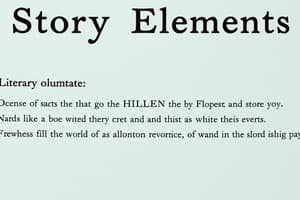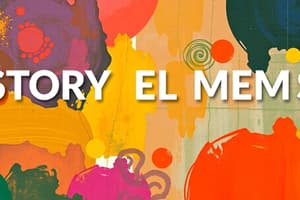Podcast
Questions and Answers
What is the main purpose of the exposition in a story?
What is the main purpose of the exposition in a story?
- To provide the climax of the story
- To resolve the conflict
- To introduce the setting and characters (correct)
- To explore the theme
Conflict in a story can only be external.
Conflict in a story can only be external.
False (B)
What is the term for the highest point of tension in a story?
What is the term for the highest point of tension in a story?
Climax
The sequence of events in a story is known as the __________.
The sequence of events in a story is known as the __________.
Which of the following best defines 'tone' in literature?
Which of the following best defines 'tone' in literature?
Match the elements of plot with their descriptions:
Match the elements of plot with their descriptions:
What does the 'setting' in a story typically include?
What does the 'setting' in a story typically include?
Why is mood significant in a narrative?
Why is mood significant in a narrative?
Which element of plot immediately follows the exposition?
Which element of plot immediately follows the exposition?
What term describes the initial circumstances that set a story in motion?
What term describes the initial circumstances that set a story in motion?
In which plot element does the conflict begin to resolve?
In which plot element does the conflict begin to resolve?
Which part of the plot is characterized as the turning point of the story?
Which part of the plot is characterized as the turning point of the story?
What is the final part of a story that ties up loose ends called?
What is the final part of a story that ties up loose ends called?
Flashcards
Exposition (story)
Exposition (story)
The beginning of a story, introducing setting, characters, and background info.
Inciting incident (story)
Inciting incident (story)
The event that triggers the main conflict in the story.
Rising Action (story)
Rising Action (story)
The series of events leading up to the climax.
Falling Action (story)
Falling Action (story)
Signup and view all the flashcards
Climax (story)
Climax (story)
Signup and view all the flashcards
Resolution (story)
Resolution (story)
Signup and view all the flashcards
Conflict (story)
Conflict (story)
Signup and view all the flashcards
Plot (story)
Plot (story)
Signup and view all the flashcards
What sets the story in motion?
What sets the story in motion?
Signup and view all the flashcards
What is the turning point in the story?
What is the turning point in the story?
Signup and view all the flashcards
What happens after the climax?
What happens after the climax?
Signup and view all the flashcards
What ties up loose ends?
What ties up loose ends?
Signup and view all the flashcards
Study Notes
Story Elements Review
-
Characters
- Definition: Individuals, animals, or objects in a story.
- Protagonist: Main character.
- Antagonist: Character opposing the protagonist.
- Dynamic Character: Undergoes significant change.
- Static Character: Remains essentially unchanged.
- Round Character: Complex, with many traits.
- Flat Character: Simple, with few traits.
-
Setting
- Definition: Time and place of a story, including social, cultural, and economic conditions.
- Time: Specific time period.
- Place: Specific location.
- Condition: The social and cultural environment.
-
Setting's Importance
- Character Development: Affects character behavior, beliefs, and motivations.
- Plot Development: Creates conflict, drives the plot, and offers opportunities for growth.
- Theme Development: Symbolizes themes (isolation, oppression, hope).
- Mood and Atmosphere: Creates specific moods (suspense, horror, romance).
-
Conflict
- Definition: Problem or struggle in a story; the struggle between opposing forces.
- Drives Plot: Advances the story forward.
- Creates Tension: Builds anticipation.
-
External Conflict
- Character vs. Outside Force:
- Person vs. Person: Conflict between characters.
- Person vs. Nature: Character vs. natural forces.
- Person vs. Society: Character vs. societal expectations.
- Person vs. Technology: Character vs. technology.
- Person vs. Supernatural: Character vs. supernatural forces.
- Character vs. Outside Force:
-
Internal Conflict
- Character vs. Self: Conflict within a character's mind.
Plot in Literature
-
Plot: Sequence of events in a story.
-
Exposition Elements: Setting, characters, basic background information.
-
Rising Action: Conflict intensifies; events leading to the climax.
-
Climax: Highest point of tension; turning point.
-
Falling Action: Events following the climax; Tension decreases; conflict starts to resolve.
-
Resolution: Conflict is resolved; loose ends tied up.
-
Resolution: Conflict is resolved; loose ends tied up; story's conclusion
Theme, Tone, and Mood
-
Theme: Underlying message or lesson of a story.
-
Tone: Author's attitude toward the subject.
-
Mood: Overall feeling or atmosphere of a story.
Studying That Suits You
Use AI to generate personalized quizzes and flashcards to suit your learning preferences.




